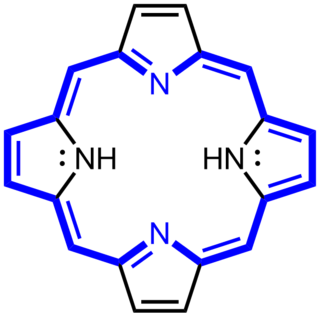
Porphyrins are a group of heterocyclic macrocycle organic compounds, composed of four modified pyrrole subunits interconnected at their α carbon atoms via methine bridges (=CH−). The parent of porphyrin is porphine, a rare chemical compound of exclusively theoretical interest. Substituted porphines are called porphyrins. With a total of 26 π-electrons, of which 18 π-electrons form a planar, continuous cycle, the porphyrin ring structure is often described as aromatic. One result of the large conjugated system is that porphyrins typically absorb strongly in the visible region of the electromagnetic spectrum, i.e. they are deeply colored. The name "porphyrin" derives from the Greek word πορφύρα (porphyra), meaning purple.

Photodynamic therapy (PDT), is a form of phototherapy involving light and a photosensitizing chemical substance, used in conjunction with molecular oxygen to elicit cell death (phototoxicity). PDT has proven ability to kill microbial cells, including bacteria, fungi and viruses.

A fluorophore is a fluorescent chemical compound that can re-emit light upon light excitation. Fluorophores typically contain several combined aromatic groups, or planar or cyclic molecules with several π bonds.
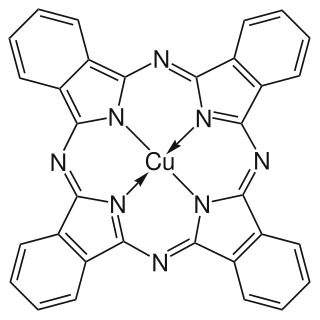
Phthalocyanine Blue BN, also called by many names, is a bright, crystalline, synthetic blue pigment from the group of phthalocyanine dyes. Its brilliant blue is frequently used in paints and dyes. It is highly valued for its superior properties such as light fastness, tinting strength, covering power and resistance to the effects of alkalis and acids. It has the appearance of a blue powder, insoluble in most solvents including water.
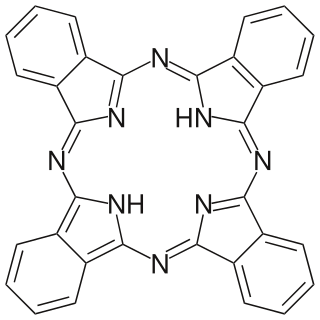
Phthalocyanine (H2Pc) is a large, aromatic, macrocyclic, organic compound with the formula (C8H4N2)4H2 and is of theoretical or specialized interest. It is composed of four isoindole units linked by nitrogen atoms. H2Pc has a two-dimensional geometry and a ring system consisting of 18 π-electrons. The extensive delocalization of the π-electrons affords the molecule useful properties, lending itself to applications in dyes and pigments. Metal complexes derived from Pc2−
, the conjugate base of H2Pc, are valuable in catalysis, organic solar cells, and photodynamic therapy.

A corrole is an aromatic organic chemical tetrapyrrole, the structure of which is similar to the corrin ring, which is also present in cobalamin (vitamin B12). The ring consists of nineteen carbon atoms, with four nitrogen atoms in the core of the molecule. In this sense, corrole is very similar to porphyrin, which is also an organic macrocycle but has twenty carbon atoms and is found in hemoglobin and chlorophyll.

A chromophore is the part of a molecule responsible for its color. The color that is seen by our eyes is the one not absorbed within a certain wavelength spectrum of visible light. The chromophore is a region in the molecule where the energy difference between two separate molecular orbitals falls within the range of the visible spectrum. Visible light that hits the chromophore can thus be absorbed by exciting an electron from its ground state into an excited state. In biological molecules that serve to capture or detect light energy, the chromophore is the moiety that causes a conformational change of the molecule when hit by light.

Porphine or porphin is an organic chemical compound with formula C
20H
14N
4. The molecule consists of four pyrrole-like rings joined by four methine (=CH−) groups to form a larger macrocycle ring, which makes it the simplest of the tetrapyrroles. It is an aromatic and heterocyclic compound, solid at room temperature.

Uroporphyrinogen III is a tetrapyrrole, the first macrocyclic intermediate in the biosynthesis of heme, chlorophyll, vitamin B12, and siroheme. It is a colorless compound, like other porphyrinogens.

Protoporphyrin IX is an organic compound, specifically a porphyrin, that plays an important role in living organisms as a precursor to other critical compounds like hemoglobin and chlorophyll. It is a deeply colored solid that is not soluble in basic water. The name is often abbreviated as PPIX.
In chemistry, a (redox) non-innocent ligand is a ligand in a metal complex where the oxidation state is not clear. Typically, complexes containing non-innocent ligands are redox active at mild potentials. The concept assumes that redox reactions in metal complexes are either metal or ligand localized, which is a simplification, albeit a useful one.

Heinz Falk is professor emeritus for organic chemistry at Johannes Kepler University of Linz and editor of "Progress in the Chemistry of Organic Natural Compounds". His research is focused on structural analysis, synthesis, stereochemistry and photochemistry of plant and animal photosensitizing and photosensory pigments, such as hypericin.
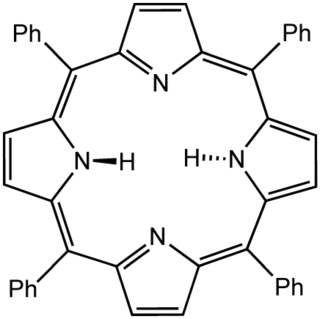
Tetraphenylporphyrin, abbreviated TPP or H2TPP, is a synthetic heterocyclic compound that resembles naturally occurring porphyrins. Porphyrins are dyes and cofactors found in hemoglobin and cytochromes and are related to chlorophyll and vitamin B12. The study of naturally occurring porphyrins is complicated by their low symmetry and the presence of polar substituents. Tetraphenylporphyrin is hydrophobic, symmetrically substituted, and easily synthesized. The compound is a dark purple solid that dissolves in nonpolar organic solvents such as chloroform and benzene.

Anthony Gerard Martin Barrett FRS, FMedSci is a British chemist, and Sir Derek Barton Professor of Synthesis, Glaxo Professor of Organic Chemistry at Imperial College London. He is Director of the Wolfson Centre for Organic Chemistry in Medical Science. He was elected a fellow of the Royal Society in 1999 and Academy of Medical Sciences in 2003. He obtained a BSc as well as PhD from Imperial College London in 1973 and 1975 respectively.

The tropocoronand ligand (H2TC-m,n) is a macrocyclic ligand in which two aminotroponiminate rings are connected to one another via polymethylene linker chains of length m and n. Double deprotonation of the ligand yields a dianionic macrocylic species that is capable of binding divalent transition metal ions to form neutral complexes [M(TC-m,n)]. The 2-aminotroponeimine units are bridged by polymethylene linker chains with all four nitrogen atoms of the tropocoronand ligand bonded to a metal atom.
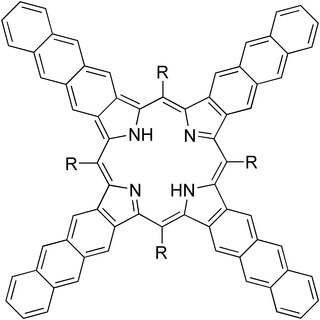
Tetraanthraporphyrin, or tetraanthra[2,3]porphyrin (TAP), is a representative of extended porphyrins. Despite promising properties, tetraanthraporphyrins have until recently been little studied. As was theoretically predicted, extension of pi-electronic system results in the case of TAPs in the destabilization of the third LUMOs and the first HOMOs that makes it unstable against oxidation and reduction.
In chemistry, a macrocyclic ligand is a macrocycle with a ring size of at least nine and three or more donor sites. Classic examples are crown ethers and porphyrins. Macrocyclic ligands exhibit particularly high affinity for metal ions.
Boron porphyrins are a variety of porphyrin, a common macrocycle used for photosensitization and metal trapping applications, that incorporate boron. The central four nitrogen atoms in a porphyrin macrocycle form a unique molecular pocket which is known to accommodate transition metals of various sizes and oxidation states. Due to the diversity of binding modes available to porphyrin, there is a growing interest in introducing other elements into this pocket.

Hexahydroporphine is an organic chemical compound with formula C
20H
20N
4. The molecule consists of four pyrrole rings connected by methylene bridges −CH
2− into a larger (non-aromatic) macrocycle ring, which makes it one of the simplest tetrapyrroles, and the simplest "true" one. As indicated by the name, it may be viewed as derived from porphine by the addition of six hydrogen atoms: four on the methine bridges, and two on the nitrogen atoms.
Thermally activated delayed fluorescence (TADF) is a process through which a molecular species in a non-emitting excited state can incorporate surrounding thermal energy to change states and only then undergo light emission. The TADF process involves an excited molecular species in a triplet state, which commonly has a forbidden transition to the ground state termed phosphorescence. By absorbing nearby thermal energy the triplet state can undergo reverse intersystem crossing (RISC) converting it to a singlet state, which can then de-excite to the ground state and emit light in a process termed fluorescence. Along with fluorescent and phosphorescent compounds, TADF compounds are one of the three main light-emitting materials used in organic light-emitting diodes (OLEDs).

















